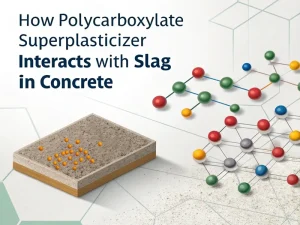Blog

Superplasticizers, also known as high range water reducers (HRWR superplasticizer) , are additives used in manufacturing high-strength concrete or pouring self-compacting concrete.
Concrete is one of the world’s most widely used construction materials today. In recent years, with the rapid development of construction, road and bridge, and municipal infrastructure projects, the average annual production of concrete worldwide has exceeded six billion cubic meters.
Superplasticizers, as the most widely used admixture in concrete, can significantly reduce the water consumption of concrete mixing, improve concrete compatibility, and ensure concrete’s strength and durability.
The development of Superplasticizer types can be divided into three stages.
The first generation of ordinary Superplasticizers, on behalf of the type of Superplasticizers, are lignosulfonate, stearic acid soap, sodium rosinate, and so on.
Take lignosulfonate (LS) as an example; it is a powdery, low air-entraining retarder, belongs to anionic surface-active substances, has adsorption and dispersion effects on cement, and can improve various physical properties of concrete. It can be compounded into early-strength agents, retarders, antifreeze agents, pumping agents, and so on. The water reduction rate can reach 9-11%.
The first generation of Superplasticizers is gradually replaced by the second generation due to the large dosage and low water reduction rate. However, some places will still use other superplasticizers to reduce the cost.
The representative superplasticizers of the second generation are melamine-based Superplasticizers, naphthalene-based superplasticizers, sulfamic acid-based superplasticizers, and aliphatic superplasticizers.
Adding melamine superplasticizers of concrete early strength development faster, small air-entraining, and good compatibility.
Naphthalene superplasticizers and melamine water-reducing performance are similar, but mixed with the concrete slump loss is more extensive, and there is a production of pollution, the water reduction rate of up to 15-25%.
Sulfamic acid superplasticizers are the product of the condensation reaction of formaldehyde, phenol, and amino aryl sulfonate. Its water-reducing performance and naphthalene system compared with the better, but the production cost is high and harmful to the environment, so it can’t be widely used.
Aliphatic sulfonate superplasticizers, although the production process is simple, the dispersing effect is good, and no pollution, but the appearance of the concrete after mixing is not good, and its application is also minimal.
The third generation of Superplasticizers, on behalf of the Superplasticizers for the polycarboxylate superplasticizers, it is not only a low dosage, high water reduction rate, water reduction rate of up to 25-40%, and can significantly improve the strength of concrete, especially in line with the requirements of the pumping concrete construction.
Polycarboxylic superplasticizers also belongs to the green, non-toxic and harmless type of Superplasticizers, suitable for the social and sustainable development.
As the latest type of water reducer, polycarboxylate superplasticizer has become a widely used and indispensable additive in large-scale infrastructure construction. With the increasing demand for engineering quality and cost control, more and more people are realizing the value of polycarboxylate superplasticizers and becoming the mainstream choice for more people.
As a supplier of polycarboxylic superplasticizers, our company produces polycarboxylate superplasticizers and polycarboxylate superplasticizers monomers.
If you need them, please get in touch with me!

How Polycarboxylate Polyether Monomer Affect Concrete Performance
Blog How Polycarboxylate

How Polycarboxylate Superplasticizer Interacts With Slag In Concrete
Blog How Polycarboxylate